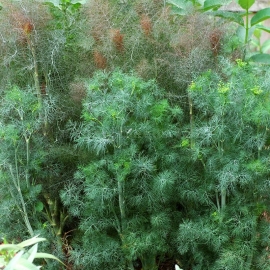
«Firework» - Organic Dill Seeds
1.14 €
This is a late-ripening variety. The first harvesting of greenery is carried out in 50-65 days. Plant shrub, height 45-55 cm, weight 70-100 grams. The leaves are large, 12-16 cm long, light green with a weak waxy coating, excellent taste and aroma.
-
Ukrainian Heirloom Dill «Firework»
This is a late-ripening variety. The first harvesting of greenery is carried out in 50-65 days. Plant shrub, height 45-55 cm, weight 70-100 grams. The leaves are large, 12-16 cm long, light green with a weak waxy coating, excellent taste and aroma.
The variety is valued for slow stalking, which allows to extend the period of economic validity. Used for fresh consumption, drying and canning.
How to Grow
In addition to providing aromatic seeds and foliage, dill will brighten your garden with its yellow-green flowers in spring and fall. While typical dill grows to a height of 2 to 4 feet, Fernleaf dill is more compact, growing only 18 to 24 inches tall. It is a warm-season annual, but really loves mild weather–not too hot, not too cold. With its slender stem and delicate leaves, it makes a good mid- to back-of-the-border addition to your garden. Try growing dill in a spot where it can easily reseed.
Dill likes direct sun and rich, well-drained soil with a pH between 5.5 and 6.5. Use organic matter to enrich the soil before planting. This plant likes mild weather and is best in the spring and again in fall. You may set out plants following the last spring frost and then plant again two months prior to the first winter frost. Space them 12 to 15 inches apart. Be sure to keep plants watered in dry weather.
Plants may need staking when in bloom to keep the tall flower stems-true butterfly magnets-from falling over, especially if you get a lot of wind. You can keep plants cut to delay flowering and extend your harvest, or harvest the whole plant as soon it flowers. The first winter frost will kill dill planted in the fall. However, if it had time to go to seed, the fallen seed may produce new plants in the spring.
